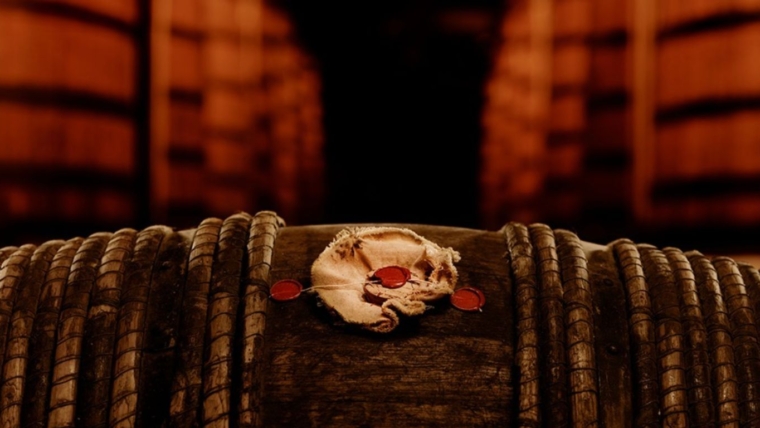ONE OF THE OLDEST WINE ESTATES IN THE BORDEAUX REGION, CHÂTEAU D’ISSAN OFFERS A TYPICAL CHARACTER REPRESENTATIVE OF THE MARGAUX APPELLATION
Since the 18th century, the Issan estate has offered a perfect balance between its 52-hectare AOC Margaux vineyard to the west – the historic part of which is located in the center of a stone wall built in 1644 – and its 50-hectare natural area of mixed farming to the east along the banks of the estuary. The property is careful to preserve the four refuge zones historically present on the estate which play a major role in the balance of its vineyard: water, polyculture, trees, and a stone wall “Clos”.
Respecting this ecosystem and its biodiversity allows enhancing the quality and balance of Château D’Issan Margaux’s wines.
WATER: A PRECIOUS REFUGE OF THE ISSAN DOMAIN
The Estuary: It is precisely because of the Gironde estuary that the Issan terroirs are so complex and renowned. The property is located nearly 600 m from the banks of this estuary (the largest in Europe). Historically, before the island of Issan came to naturally stick to the bank during the 19th century, the property was only 400 m from the estuary. It constitutes a natural environment with an important biodiversity that protects the vineyard in particular to face the frost and the excess of heat.
The historical ditches: a unique water network: Facing south-west, the ancestral vineyard of the Clos benefits from an excellent drainage brought and reinforced by several ditches which cross it since the 16th century. These ditches flow into the Maqueline canal which flows into the Gironde estuary. This unique water network ensures the drainage of the gravel plateau and allows the vines to have a constant and regular supply of water. Rehabilitated since the 1960s, they represent an ecological corridor of more than 12 km between the Margaux vineyard plateau and the natural polyculture area. Aquatic vegetation develops there, attracting fauna specific to wetlands: dragonflies, reptiles and amphibians.
These ditches have a beneficial effect on the quality of water by playing a phyto-repellent role thanks to the vegetation present (rushes, reeds, ash trees, cattails…). Favorable to the reproduction of certain insects, they also constitute a refuge area for crop protection agents. Finally, they actively participate in the diversity of the Issan landscape by allowing the development of species that come to feed and take refuge there.
The moat of the Castle: A historical vestige, the moat encircles the central platform where the Castle of Issan, rebuilt in 1626, is located. Fed by rainwater and by the drainage of the plots, they are 2 meters deep. They are home to and complement an aquatic fauna and flora.
POLYCULTURE: A REFUGE PRESERVED SINCE THE EIGHTEENTH CENTURY
When we compare the map of the Domaine in 1759 and the one of today, we can see that the ensembles have been respected. Along the banks of the Gironde estuary, the natural polyculture area is cultivated in rotation with cereals and the following crops: wheat, alfalfa, barley, sorghum… 1/3 of fallow land is also preserved each year to allow a healthy rotation. This offers a greater variety of crops and provides a habitat for many animal species and plant species. This polyculture also provides disease control.
This area also benefits from the necessary water reserves that the Domaine naturally enjoys. A polyculture area that has been preserved for centuries, bordering the Issan vineyard, it is unique in the Médoc and constitutes a force of balance.
THE TREES: A REFUGE IN RENEWAL
The fruit trees: To the southeast is the historic alley of the 45th parallel crossing the polyculture space in the heart. In 2020, nearly 70 species of trees were planted here: cherry, plum, apple, pear, quince, swamp oak, red maple, walnut…
The main alley that separates the two appellations: This axis, located to the south of the Château, is lined with trees, some of which are more than 25 meters high. It represents a real backbone of shade in summer, making it a major asset within the Domaine.
THE CLOS: 360° REFUGES
The historical clos: The Issan vineyard, enclosed by a wall since 1644, benefits from a virtuous cycle that constitutes a strength for the ecosystem of the property. The walled vineyard of Issan, which extends over 1.8 km in length, acts as an insect hotel. Ants and solitary wasps find refuge there. This stone wall also provides shelter and cover for many small mammals and rodents such as shrews, field mice or voles.
In addition to being a physical shelter (protection against rain, snow, wind, predators…), this wall has the advantage of accumulating heat during the day and releasing it during the night: thanks to the thermal inertia provided by its mass, it offers a more stable temperature and allows animals to warm up or take shelter. Hedgehogs, bats… also come to hide or reproduce there. The enclosure is thus a determining factor for biodiversity.
The planted clos: In its continuity, the polyculture zone is surrounded by a vegetal fence with a diversity of trees: elms, ashes, willows, hawthorns… This green frame, like a hedge, constitutes a real natural corridor. By serving as a place of life and reproduction for fauna and flora, it facilitates the dispersion of species and the diffusion of biodiversity, thus fighting against the fragmentation of habitats so detrimental to wildlife.
THE CHÂTEAU IS OPEN TO THE PUBLIC FOR TOURS
Château D’Issan is open for visits all year round by appointment for private and tailor-made visits. They offer different tastings including L’horizontale, la Familiale, La Royale.
PRACTICAL INFORMATION
For more on luxury lifestyle, travel and news follow our Instagram and subscribe to our VIP network to access special invites, discounts, and upgrades.



